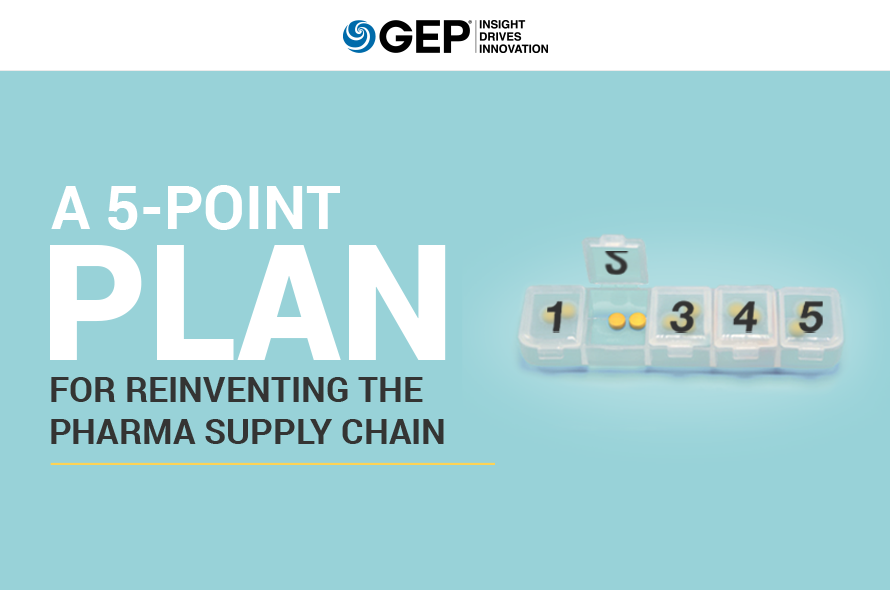Slow production cycles, long lead times, high inventory levels — all typical of the traditional pharmaceutical supply chain. And all increasingly incompatible in a world where market forces and new technologies are redefining the industry’s priorities and goals. What can supply chain leaders do to keep up with the pace of change and give the pharma business the boost it so badly needs?
This white paper — A 5-Point Plan for Reinventing the Pharma Supply Chain — examines the major challenges pharma companies face today and how they can be addressed with digitally transformed, lean, agile supply chains.
Why Read It:
- Today’s key challenges for the pharma sector
- Achieving agility with a digitally transformed supply chain
- Strategies for taking supply chain from support function to business partner
A must-read for enterprise leaders who want to build a digital supply chain that can support their organization’s growth plans and business goals.
The life sciences and pharmaceutical industry has experienced an onrush of new trends during the last few years; it’s probably going through more flux than any other sector. New drugs, new manufacturing techniques, new technologies, new regulations, new priorities mean that the industry’s procurement, logistics and distribution networks — in fact, its entire supply chain — need to adapt and evolve.
How can the supply chain add value and give the business a competitive edge?
The pharma industry needs an agile supply chain where everything is connected, data is real time, every step visible, every process traceable. It needs a supply chain that can respond quickly and proactively to fluctuating demand, where the safety and integrity of the product are not compromised, where there are no stockouts and no wastage, and where the costs are optimized.
In this paper, we look at the big changes and challenges that pharma companies face and the key priorities for the industry at this point in time. We outline five strategies that will help reinvent the life sciences and pharma supply chain, and make it a true business partner instead of just a support function.

CHANGING FUNDAMENTALS IN THE INDUSTRY
Over the past decade or so, the dynamics have changed for life sciences and pharmaceutical companies, which for years enjoyed patent protections, captive markets, high margins and fast growth. Companies are now looking at new strategies to exploit what continues to be a growing, but complex market; the pharmaceutical market will touch nearly $1.5 trillion by 2021, an increase of nearly $370 billion from the $1.1 trillion recorded in 20161.
Businesses are prioritizing the development of the new generation of drugs and therapies such as biologics and personalized medicines, which require high investment in equipment and technology. Across companies, returns from research and development (R&D) have slowed down, but R&D holds the key to success for pharma companies, so it remains a priority.

For market expansion and growth, companies are also increasingly looking at emerging markets that have growing populations and a large middle class. There is rapid growth in the market and research environment in emerging economies. During the 2013-2017 period, the Brazilian, Chinese and Indian markets grew by 11.5%, 9.4% and 11%, respectively, compared to an average market growth of 4.4% for the top five European Union markets and 7.3% for the U.S. market2. The industry has been seeing a lot of mergers and acquisitions as businesses look for opportunities to expand markets and portfolios but keep costs under control.
Pharma companies have been set in their ways, with traditional processes, limited lean practices and flexibility built into operations. But lower revenue margins and the need for capital have them exploring ways to streamline operations. The one significant way to increase operational efficiencies and become more cost-effective is to focus on a function where there is scope for improvement — the supply chain.
The traditional supply chain has not been able to cope with the changing needs of the industry, which has thrown up new challenges and complexities.
KEY CHANGES AND CHALLENGES THE INDUSTRY FACES
- Complex Product Portfolios: Biologics and personalized treatments tend to be time- and temperature-sensitive and need different sourcing and production processes. They require a more innovative, resilient supply chain, with smart factories, decentralized production (so it is closer to the customer), and cold or cryogenic transportation and storage, among other things. They need more meticulous planning compared to regular small-molecule drugs.

- Rise in Generics: As drug patents expire and cheaper generic drugs hit the market, companies are losing the high margins they had been enjoying because of their blockbuster drugs. Generics now account for 90% of prescription drug use in the U.S., according to the FDA. Global generic spending is expected to increase to $495-505 billion by 20213. Leveraging the partnerships that the supply chain has with its suppliers, distributors and retailers is critical to managing the resulting competition and dipping profit margins.
- Increased Regulations: Drugs are among the most regulated items, facing checks and mandates at every step of the process, from R&D and clinical trials to production and delivery. As companies expand their sourcing and market bases, there are more and more rules to comply with, which have varying impacts, from lengthening the time it takes for a drug to hit the market to adding financial pressure and reducing revenues. For example, many governments keep tight price control over drugs. In 2018, China reduced the prices of 36 drugs developed by multinational pharma companies by an average of 44%. In late 2017, India’s National Pharmaceutical Pricing Authority capped the prices of 51 essential formulations, reducing their cost by up to 53%4. Similarly, more and more countries have begun imposing track-and-trace regulations to curb counterfeiting. In 2013, the U.S. passed laws that made serialization mandatory to enable identification and tracking of drugs through their life cycle. This phased rollout started in 2015 and will continue until 20235. In 2018, a similar regulation took effect in the EU.
- Market Uncertainty: The changing global market dynamics and geopolitical issues — such as Brexit and the trade war between the U.S. and China — as well as the shifting needs of customers have created many uncertainties. Demand has become variable and unpredictable, adding to supply chain complexity.
How then can the supply chain become a strategic partner that enables businesses to cope with these challenges? The traditional slow-production-long-lead-time-high-inventory model, which could be supported by high profit margins of blockbuster drugs and market monopolies, has served its time. Companies now need a highly responsive supply chain whose complexities must be managed efficiently.
SHIFT TO AN AGILE, RESPONSIVE SUPPLY CHAIN
Despite analysis of data and forecasts, demand remains subject to significant fluctuation in the life sciences and pharma sector. The goal, then, must be to establish a supply chain that is flexible and can respond quickly to shifts in demand. Agility implies responsiveness from one end of the supply chain to the other and focuses on eliminating barriers to speedy response. An agile supply chain is distinguished by its ability to identify changes, adapt to different conditions, and respond proactively.
Pharma companies can look at increased outsourcing, larger vendor base, storing inventory closer to markets, production postponement and late-stage market optimization to cut lead times, increase flexibility and, at the same time, prevent overstocking and wastage. (For instance, packaging can be customized based on the region it needs to go to once the order is received.)
Life sciences and pharma firms have to work with longer lead times compared to many other sectors, so end-to-end supply chain planning is even more critical and will get them one step closer to achieving agility.
For a responsive supply chain, businesses must develop capabilities to detect changes, patterns and events as they occur. It is important to understand changes from the point of their impact on operations and to determine what changes will have the greatest effect, and then to prioritize agility in those areas.
Developing an agile supply chain requires a holistic approach; it can’t be done piecemeal. A business is not going to gain much if its supply chain is agile but not its finance function. Taking this one step further, businesses must also evaluate their partners, such as Contract Manufacturing Organizations (CMOs) and logistics providers, for agility.
Agility is likely to introduce more complexity into the supply chain, so businesses must consider the trade-off. Sometimes, agility translates into lower costs, but not always. For instance, storing stock closer to the market/customer will help the company react faster, but it will require investment.

MANAGE SUPPLY CHAIN COMPLEXITY
The primary contributors to complexity in the pharma supply chain are the nature of the drugs, large portfolios, increased regulations, expansion into a borderless global market, increased outsourcing, personalized medicines and the forward-reverse flow of products. None of these factors are going to go away, so the complexity is here to stay. Complex, however, does not have to mean complicated. The goal, then, should be to manage complexity.
Stay Connected: The basic requirement for managing a complex supply chain is to keep the enterprise’s internal and external partners — suppliers, manufacturers, distributors, logistics providers, pharmacies, and everyone else involved — connected at all times. This capability, which will allow all partners to collaborate and work in sync with one another, can be achieved via the cloud, not ERP systems that limit connectivity to the four walls of the organization. A digital supply chain should create end-to-end visibility, enable real-time updates and empower stakeholder coordination.
Get Smart: To fully benefit from a digital supply chain, businesses must upgrade to digitized, connected production facilities that use artificial intelligence (AI), big data, the Internet of Things

(IoT) and robotics in the manufacturing process, making them adaptable, flexible and self- correcting. The smart factory — integrating smart manufacturing and the digital supply chain — is vital for managing complexity.
Plan Efficiently: Any industry will benefit from improved supply chain planning, but the pharma sector, in the throes of upheaval and operating under a complex set of factors, especially stands to gain.
An efficient planning process will involve not just procurement and supply chain but also other functions such as sales and finance. It will factor in real-time market intelligence and be aligned with the company’s business goals.
Forward planning will allow companies to anticipate requirements and risks; accommodate technology, manufacturing and equipment upgrades; forecast demand and maintain buffers for disruption — basically, to handle complicated scenarios with greater ease.
However, this does not mean that all planning and processes have to be centralized. When the business is spread across global markets, localizing certain processes and functions may add far more value as well as cut complexity in the supply chain.
Here, we look at a five-point plan that will help achieve the two goals of creating agility and managing complexity.
FIVE STRATEGIES TO OVERHAUL THE PHARMA SUPPLY CHAIN
1. Digitize the Supply Chain
The most effective way to streamline and optimize the supply chain is through automation and digitization — that is, building a digital supply chain. Enterprises must have end-to-end process visibility, centralized data collection and analytical tools that interpret the data and make accurate forecasts, all in real time.
The solution is to implement a cloud-based unified software system that makes available real-time data, has powerful reporting tools and demand sensing technology, and also integrates seamlessly with existing systems. New technologies such as AI, IoT, machine learning and blockchain can be powerful tools for achieving real-time visibility, for automating repetitive processes and for predictive analytics.
With life sciences and pharmaceutical firms, any major investment, be it in production, equipment, supply chain or technology, gets weighed against the need to invest in R&D, always an expensive undertaking. But the capital employed to improve processes will bring good return on investment even in the short term, improving speed, efficiency and productivity, reducing wastage, and preventing shortages, which collectively contribute to greater savings and profitability.

Businesses can also seek advice and support from experts to redesign their supply chain, implement best practices, optimize process flow, strike cost-effective sourcing deals, negotiate better contracts, evaluate vendor performance, and transform the supply chain into an agile, flexible supply “nexus” suited to the handle challenges and opportunities unique to the sector.
2. Increase Visibility and Security
The World Health Organization estimates that up to 1% of medicines available in the developed world are likely to be fraudulent. This figure rises to 10% in various developing countries, and in parts of Asia, Africa and Latin America, fraudulent drugs amount to as much as 30% of the total market6.
To prevent diversion, adulteration and counterfeiting, and to ensure product integrity, governments have been tightening control and imposing regulations for several years now. To comply, businesses have started leveraging technology to facilitate authentication across the supply chain, using a combination of serialized labels and track-and-trace solutions for system-wide product visibility. By early 2019, more than 75% of the world’s prescription medicines are likely protected by legislation, according to a report published by the Association for Packaging and Processing Technologies7.

This visibility is needed not only to track product flow; pharma companies must also have visibility into their raw material suppliers’ operations and into the manufacturing operations of their partner CMOs, who produce the finished goods. This means the suppliers and CMOs too must have resources to be able to comply.
With such strong and close involvement of suppliers, pharma companies must work doubly hard to build long-term collaborative partnerships with them, fostering trust, involving them early in the innovation process, assessing performance, and actively managing the relationships. Effective supplier management will smooth out the path and improve overall visibility in the supply chain.
While traceability may have been imposed, it has become a valuable feature as pharma companies spread their wings globally and manufacture more and more high-value, fragile and easy-to-contaminate drugs. Tracking makes a lot of business sense as it can improve inventory management, lower risks, reduce counterfeiting, theft, and recalls, and therefore cut losses. Traceability will also drive internal efficiencies and improve accountability and compliance among suppliers.
As a strategy, businesses must explore new tracking technologies and consider what will best work for them. As packaging and printing technologies get more sophisticated, businesses can consider using a combination of overt (holograms, serial codes, barcodes) and covert technologies (foil stamping, die cutting, security inks, scratch codes). The more layers of protection, the tougher the packaging is to replicate.
3. Manage Inventory Efficiently
Pharma companies have traditionally had long lead times and slow production cycles; to counter this, they make substantial investments in large stocks of materials. However, the inroads made

by generic drugs and patent expiries are squeezing business margins, and one major strategy for freeing up working capital is to maintain tight control of inventory.
Also, the value of raw materials, the unique transportation and storage requirements of drugs, their vulnerability to contamination and the risk of counterfeiting and theft all make it imperative that there is no overstocking of inventory. At the same time, critical life-saving drugs must not run out of stock, both for reasons of ethics and reputation.
For better production planning, life sciences and pharma companies must have their fingers on the market pulse and be able to make accurate demand forecasts. Improving and speeding up customer data collection and interpreting this data will help achieve this to some extent. Companies can then segregate their inventory based on demand patterns — drugs with predictable patterns can have lower inventories, while those that are unpredictable must keep higher stocks.
It is also important for companies to build strategic, collaborative relationships with their key suppliers and their logistics and distribution partners. Organized, well-run warehouse facilities will further improve inventory management.
Good inventory management is a blend of smart inventory management techniques, strong collaborations and effective technology solutions, all of which support each other.
4. Segment and Tailor the Supply Chain
Big pharma firms tend to have a one-size-fits-all approach, maintaining high levels of inventory and high service levels for all their drugs. However, with diverse product portfolios, personalized treatments and a growing global consumer base, it may be a far more effective strategy to segment the supply chain based on various categories such as product type, product value, demand, customers and markets.
Companies can run a series of separate supply chains depending on their business priorities and goals. For example, the strategy for a patented drug will be different from a generic drug — for the blockbuster drug availability may be a top priority, while for the generic one cost optimization may be the key focus. While business assets — raw materials, production units, warehouses, logistics partners — will remain largely the same across segments, the processes and strategies for each can be different. Each supply chain can be tailored to its own product, market and customer base.
Precision medicine is highly complex and cannot be made at conventional scale or delivered using traditional supply chain processes. Consider CAR-T cell therapy, which is used to treat some types of cancers. The immune cells harvested from a patient are re-engineered and injected back into the patient so that the reprogrammed cells will fight cancer. This therapy requires collection of samples from and delivery to the patient via cold-chain logistics; it needs temperature-controlled storage facilities, cold-chain packaging to prevent temperature variations, and temperature monitors to ensure the quality of the biologic material has not been compromised.
If the business works with CMOs, it means the CMOs will need all these facilities, too. Both companies and their partners will have to build systems and services to adapt to such individualized treatment requirements. These medicines require closer monitoring and tracking, so businesses will need real-time visibility into the entire process.
Tailor-made supply chains will help pharma companies address one of the biggest challenges they face — demand fluctuation. That will help achieve inventory optimization across each segment. Overall, they will improve efficiency, raise service levels, reduce costs, ease production pressure and give businesses a competitive edge.
5. Focus on the Customer
Traditionally, life sciences and pharma companies have had more direct dealings with hospitals, pharmacies, governments and insurers than with their final customer — the patient. But shifting disease patterns, increased awareness, more participative health care, personalized therapies and e-commerce are gradually moving the focus to that final customer.
Even as businesses continue with large-batch production and generic drugs, they will have to develop capabilities to produce, store and distribute personalized treatments such as cell and gene therapies, as well as cater to multiple individual customers. Businesses cannot afford to ignore this market. The global personalized medicine market is expected to achieve over 11% growth (CAGR) during the 2017–2024 period and touch $194.4 billion by 2024, from an estimated $92.4 billion in 20178.
Another consumer-driven trend that pharma businesses must consider actively is the online marketplace. E-pharmacies are becoming increasingly popular because they offer relatively lower rates, convenience, round-the-clock delivery, availability of drugs that are otherwise tough to find and access to detailed drug information, among other things. The global e-pharmacy market size was valued at $33.03 billion in 20169, and is expected to grow at a CAGR of 17.7% between 2015 and 202310.

E-commerce can bring about changes in the supply chain by helping pharma companies get a clearer idea of demand patterns (online pharmacies will have real-time data on what’s sold and available) and thus help them better manage production and stock. This, in turn, could reduce costs related to warehousing. E-commerce can also increase and improve interactions between pharma companies and their end customers. The business advantages of an online marketplace are many, from reduction in operational costs and better inventory control to improved customer service and market expansion as a result of virtual presence.
CHANGE IS A NECESSITY
Supply chain digital transformation will inevitably touch every business in every industry, but in the pharma sector the need rises to a higher level of urgency. Drugs are among the most regulated and fragile items in the world, and their supply chain must be able to accommodate their vulnerability while supporting the evolution of the industry and the changing needs of its customers.
Reinventing the pharma supply chain will require investment in technology as well as a shift in the perspective of supply chain leaders and top-level management. The commitment must be made; the world isn’t going to wait and, in this industry, it’s not much of an exaggeration to say that lives— not just business goals and future growth — may literally be at stake.
References
- “Outlook for Global Medicines through 2021,” IQVIA Institute for Human Data Science, December 2016. Retrieved from iqvia.com/-/media/iqvia/pdfs/institute-reports/global-outlook-for-medicines-through-2021.pdf
- “The Pharmaceutical Industry in Figures: Key Data 2018,” the European Federation of Pharmaceutical Industries and Associations and IQVIA Institute, March 2018. Retrieved from efpia.eu/media/361960/efpia-pharmafigures2018_v07-hq.pdf
- “The Pharmaceutical Industry and Global Health: Facts and Figures 2017,” International Federation of Pharmaceutical Manufacturers & Associations (IFPMA), May 2017. Retrieved from ifpma.org/wp-content/uploads/2017/02/IFPMA-Facts-And-Figures-2017.pdf
- “Cost Control: Drug Pricing Policies Around the World,” Pharmaceutical Technology, 12 February 2018. Retrieved from pharmaceutical-technology.com/features/cost-control-drug-pricing-policies-around-world
- “Main Requirements and Deadlines of the DSCSA,” Adents. Retrieved from https://adents.com/usa-dscsa-serialization-requirements-deadlines
- “Counterfeit Goods: A Bargain or a Costly Mistake? Exhibit A: Phoney Pharmaceuticals - An Unfolding Public Health Tragedy,” United Nations Office on Drugs and Crime. Retrieved from https://www.unodc.org/toc/en/crimes/counterfeit-goods.html
- “Global Personalized Medicine Market – Types, Technologies and Applications,” Research and Markets, October 2018. Retrieved from researchandmarkets.com/research/n5kqz7/global?w=5
- “ePharmacy Market Analysis By Region and Segment Forecasts, 2018-2025,” Grand View Research, August 2017. Retrieved from grandviewresearch.com/industry-analysis/epharmacies-market
- “ePharmacy Market - Global Industry Analysis, Size, Share, Growth, Trends and Forecast 2015-2023,” Transparency Market Research, November 2015. Retrieved from transparencymarketresearch.com/epharmacies-market.html
Additional References
- “E-Commerce to Change the Face of Pharma Industry,” Roadcast, 28 April 2018. Retrieved from roadcast.in/blog/corporate-solutions/the-increasing- trends-in-the-e-comzzmerce-industry-shown-that-the-next-big-sector-is-pharma-companies
- “Have Questions About Generic Drugs? Get the Facts,” U.S. Food and Drug Administration. Retrieved from fda.gov/Drugs/ResourcesForYou/ Consumers/BuyingUsingMedicineSafely/GenericDrugs/default.htm
- Lemoine, Patrick. “Best Practice in Pharma Supply Chain Management,” 23 January 2017, pharmaphorum.com. Retrieved from pharmaphorum.com/ views-and-analysis/best-practice-pharma-supply-chain-management
- Lunger, John. “Supply Chain Strategies for New Therapies,” Pharma Manufacturing, 26 June 2018. Retrieved from pharmamanufacturing.com/ articles/2018/supply-chain-strategies-for-new-therapies
- McCrea, Bridget. “Delivering Pills On Demand: Automation and Digitization in Pharmaceutical Market,” Supply Chain 24/7, 10 December 2018. supplychain247.com/article/delivering_pills_on_demand_automation_and_digitization_at_pharmaceutical_co/inventory
- Ozkaya, Evren. “Pharma’s Digital Supply Chain Transformation,” Pharma Manufacturing, 4 April 2017. Retrieved from pharmamanufacturing.com/ articles/2017/pharmas-digital-supply-chain-transformation
- “Pharma 2020: Supplying the Future, PricewaterhouseCoopers. Retrieved from pwc.com/gx/en/pharma-life-sciences/pharma-2020/assets/pharma- 2020-supplying-the-future.pdf
- Reed, Carla. “8 Critical Elements of a Supply Chain Strategy — From Discovery To Commercialization,” Pharmaceutical Online, 25 June 2018. Retrieved from pharmaceuticalonline.com/doc/critical-elements-of-a-supply-chain-strategy-from-discovery-to-commercialization-0001

